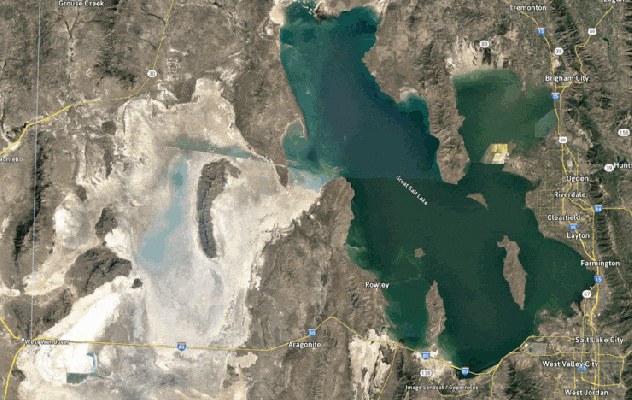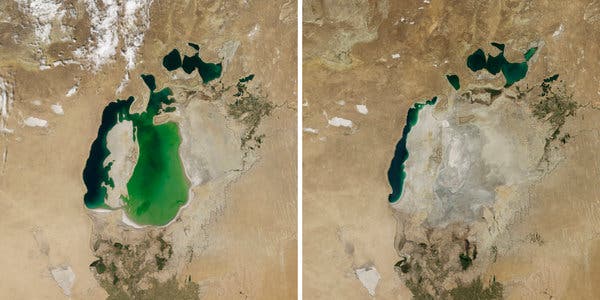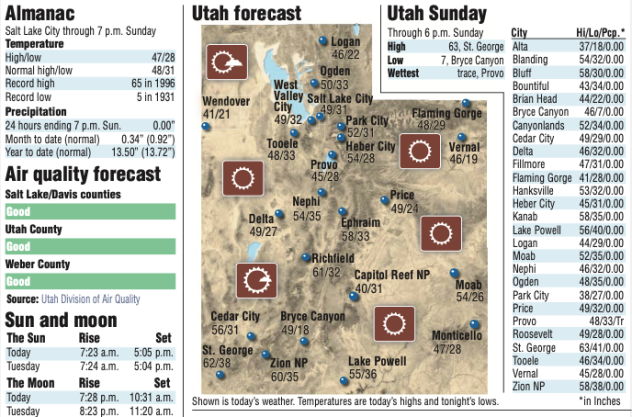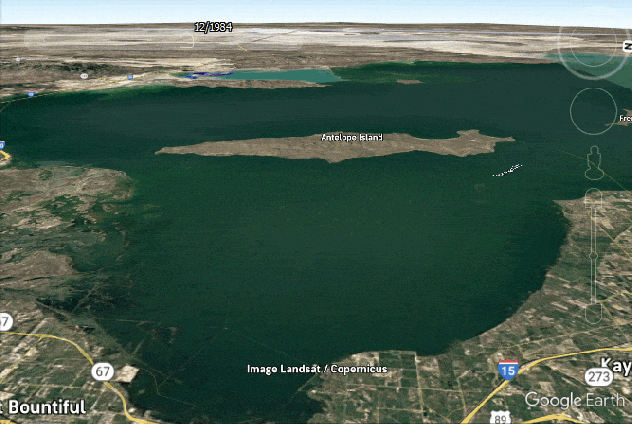
The Salt Lake Tribune newspaper on Monday began using a new map of Utah that features a fresh depiction of the Great Salt Lake in response to the drastic shrinking the iconic body of water has undergone over the last 30 years. The change to the map came with the assistance of graphics artists at AccuWeather.
A combination of river diversions and the impacts from the megadrought across the American West has driven the lake to 4,191.3 feet above sea level over the summer – the lowest levels the lake had seen since the USGS began keeping records back in 1847 – and levels continued to fall until storms moved in and agricultural irrigation ended for the season. From Oct. 15 to Oct. 18, the lake’s elevation had dropped to 4,190.3. Currently, the lake is less than half of its average size – a mere 937 square miles with a volume of 7.7 million acre-feet.
Experts believe it will be a long, difficult road to get the lake back to just its average water levels due to the strain placed on it by water diversion, which is exacerbated by drought.

This led journalists and editors at The Salt Lake Tribune, which was founded in 1871 and is among the oldest continuously published newspapers west of the Mississippi River, to question how current maps depicting the lake at its average size “have kept us from seeing the impacts of droughts, full bore.” This assessment by editors at the Salt Lake Tribune prompted them to ask AccuWeather mapmakers, whom the paper partners with, to redraw the lake.
“Our maps stay the same for the average level of the lake, and as a news organization, it doesn’t make sense anymore,” Grant Burningham, managing editor of the Salt Lake Tribune, told AccuWeather National Weather Reporter Bill Wadell. “We know the lake is smaller. We know it’s about half the size that it used to be and we have a chance to raise awareness nationally and locally when hopefully there are still some things to do to change the course of the lake, which, right now, frankly, is in a death spiral.”

Using satellite images chosen by The Salt Lake Tribune as a reference, AccuWeather’s graphics department drafted a version of the lake that showed a more current shoreline rather than how it may have looked 30 years ago. The original outline of the lake remains on the new map, but the blue shape depicting the actual water that would normally fill it in, iconic to the state’s locals, has changed.
“We’re really hoping that we have a moment here where everybody takes a look at their maps,” Burningham said, referring to other news organizations, “and says, ‘Wait a minute, this big, beautiful blue spot here which I’ve seen on a globe since I was a kid is now just a brown puddle. And it’s evaporating. And if we don’t do something, it’s going to go away.’”

Daniel Bedford, professor in the Department of Geography and Environmental Sustainability at Weber State and Director of the Honors Program, has always described the lake as a giant inkblot, like a Rorschach test.
“You look at that inkblot and you can see what you want to see in it,” he told Wadell. “It’s kind of reflecting ourselves back at us. And the future of the Great Salt Lake is really very much in our hands.”
Terminal ‘ill’ lake
The Great Salt Lake is a terminal lake, meaning that it is the last stop for the rivers and snowmelt that feed it. But over the years, river diversion for agriculture has taken “the lion’s share of water” as Lynn De Freitas, executive director of the non-profit Friends of Great Salt Lake, told Wadell.
Despite the lake being an essential cornerstone for the area’s economy, whether through tourism or the brine shrimp industry, not to mention its importance to the ecosystem, the lake isn’t considered by Utah law as beneficial, De Freitas said.
“The recognition of water coming into Great Salt Lake, by many, is still recognized as wasted,” De Freitas said.
“A lot of the problem has been that the lake drinks last, right? New development gets water. People who live here get water. Agriculture gets water,” Burningham said. “Utah as a state is currently investigating whether or not it should put another dam on the Bear River, which would drop the lake an additional 2 feet. It’s hard to see how that wouldn’t be the death knell for this lake.”
Utah Legislature passed the Bear River Development Act back in 1991, allowing the Division of Water Resources to construct reservoirs along the river and its tributaries. According to the Division of Water Resources, conservation efforts and new technology, such as secondary meters and optimization and efficiency projects, have pushed the projected need for the project back from 2015 to 2045-2050.
Water diversion problem
Kevin Perry, an associate professor in the Department of Atmospheric Sciences at the University of Utah who has studied the impacts on the lake, told Wadell that the ongoing drought accounts for only 6 of the 17 feet the lake is down from its long-term average. The other 11 feet is due to water diversions, which he stressed were conscious choices that are made about how water is used in Utah.
A study from Utah State University identified that 30% more water than is sustainable is being diverted from the lake’s intake, Perry said. In order to make up that deficit and remain sustainable in any given year, he added, the Salt Lake region would need to have 130% of a normal snowpack.
“If we have an average amount of precipitation, the lake will drop. If we have a drought situation, the lake drops even further,” Perry said. “The odds are definitely against the lake right now, and we need to collectively change our behavior, change our water use policies, so that we can end up evening the odds so that the lake is back to a natural ecosystem that will ebb and flow depending on precipitation as opposed to constantly having water siphoned out underneath of it.”
Add a dusty ARSENIC problem
The dust kicked up from the dry lakebed has also threatened to exacerbate the situation that exposed it. When sediment is picked up by the wind and carried over to the nearby mountains, it’s deposited over the snow, Bedford explained. The dust is darker in color, making the snowpack less reflective and more absorbant to sunlight, which, in turn, makes it more prone to melting than it otherwise would have been.
The lakebed dust not only finds its way to the snowpack but also into the nearby cities. Perry, whose research focuses on air quality, has spent the last five years trying to answer the question of just what’s in the dust that’s coming from the Great Salt Lake.
For two years, he biked out to collect soil samples every 500 meters on all 800 square miles of the exposed lakebed. He took those samples back to a laboratory where he examined them and determined what was in the soil.
Arsenic, in particular, caught his attention.
The samples had been taken from parts of the dried-up lakebed that had been exposed for anywhere from a few months to 20 years.
“Every single measurement that I took out on the Great Salt Lake had higher arsenic concentrations than would be recommended by the Environmental Protection Agency,” Perry said, surmising that due to the measurements being above that limit, the implication is that the mineral was a naturally-occurring element in the area that erosion from the mountains ends up depositing in the lake.
Arsenic, a natural component that occurs in many minerals, is a carcinogenic compound, and chronic exposure to it over a period of decades can lead to increases in lung cancer. However, even if the dust didn’t contain arsenic, it would still pose a health hazard if the concentration was high enough, Perry added.
“You breathe it [a large amount of dust], you have an immediate response. You end up in the hospital or the emergency room as opposed to the long-term chronic exposure to the arsenic that I was talking about before,” Perry said. “So, what I’m actually more concerned about right now is these acute impacts of these short-lived dust storms that bring very high concentrations of dust into the adjacent areas, exposing more than a million people to potentially unhealthy air quality.”
Nearly 3 million people live around the Great Salt Lake.
Not far from Utah, Owens Lake serves as a small glimpse of the impact lakebed dust can have on air quality.
Water from the Owens River, which fed the lake, was diverted to the Los Angeles Aqueduct, leading to the lake drying up. For 50 years, the dry lakebed of Owens Lake has been the largest source of dust in North America despite the $2 billion put into trying to mitigate the dust without adding water back into the lake.
The Great Salt Lake is more than 10 times the size of Owens Lake, and Perry warned that it is a potentially larger dust source that would affect millions of people who live adjacent to it.
“My long-term concern is that as the lake continues to shrink, it will expose more of this lakebed sediment, the frequency of these dust storms will increase, and the severity of those dust storms will increase, and it will become an issue for all the people in Northern Utah,” Perry said.
You should really watch the documentary film: Megadrought – Vanishing Water and prepare accordingly!
Great Salt Lake disappearance is sure
Other terminal basins have shown that even the size of the Great Salt Lake won’t protect it from nearly disappearing.
The Aral Sea in Asia, which was once the fourth-largest lake in the world, drastically shrank after the rivers that fed it were diverted for Soviet irrigation projects. The dried-up eastern basin is now the Aralkum Desert.
Lake Poopó, once the second-largest lake in Bolivia, was also humbled by a combination of drought and water diversions for mining and agriculture. The lake has dried up as of December 2015, and scientists are not optimistic about its recovery.
Perry said that the Great Salt Lake will most likely always have a remnant of water rather than completely drying up, but he warned the ecosystem seen there today won’t be the same. Many parts of the lake are already undergoing such an impact.
Over the summer of 2021, the lake level not only dipped to a record low but to a level that also exposed a critical part of the environment’s ecosystem.
The foundation of the Great Salt Lake’s ecosystem takes the form of something that looks more akin to a rock than anything living. Microbialites, made of photosynthetic microbes and cyanobacteria, sit at the bottom of the food chain of the Great Salt Lake and provide 30% of the energy of the ecosystem.
However, as water levels dropped lower than the lake has seen before, many microbialites were left exposed to the sun’s rays.
“When they’re exposed like they were this summer, they die very quickly, and we don’t know how long they take to be restored because we’ve never seen lake levels like this,” Jaimi Butler, Great Salt Lake Institute coordinator at Westminster College, told AccuWeather. Since this is something that has never happened before in the lake’s history, Butler said, no one knows what the result will be until at least the summer of 2022.
The impacts, however, are likely to ripple up the already struggling food chain.
“We’re all this interconnected system of Great Salt Lake,” Butler said.
Brine shrimp and brine fly larvae depend on microbialites for food, which, in turn, feed the thousands of migratory birds that create a multi-million-dollar opportunity for the lake’s tourism industry.
Ecosystem collapse
More than 10 million migratory birds visit the Great Salt Lake as they migrate between the northern and southern hemispheres, which the tourism industry in the area has used to its advantage. The Great Salt Lake Bird Festival held in the spring attracts bird watchers from across the nation, contributing to the $1.3 billion that the tourism industry gains from the lake.
Habitat loss has also been a concern as the water recedes.
The Locomotive Springs Wildlife Management area on the northern side of the lake was once a vibrant wetland with millions of birds, but when the groundwater that fed the area dried up, it became just another part of the dried lakebed.
“It’s just empty,” Perry said. “It’s barren. The millions of birds that were out there are gone, and they’re not coming back anytime soon.”
On the southern side of the lake, Antelope Island is no longer an island. Nor is it a safe haven any longer for migrating birds. As the water receded, it provided a path for predators such as coyotes to cross over and threaten resting birds.

Bedford added that the area has undergone significant bird die-off, as well as disease, spread as a result of the declining lake levels.
Increase in salinity and tourism apocalypse
The increase in salinity due to less water also creates a more challenging environment for the brine shrimp and flies – a critical food source for the birds as well as a source of income for brine shrimp fishers.
“We’re seeing an increase in salt content in the lake because there’s not as much water to dilute it, and we know that certainly affects everywhere from microorganisms to the brine shrimp and the flies and where the birds hang out,” Butler said. “It’s like a death by 1,000 cuts.”
As the multi-million-dollar industries that rely on the health of the ecosystem take a hit from low water levels, the recreation sector of tourism is recording its own losses.
At the Great Salt Lake Mariana, most boats sit out of the water – their drafts too deep to be out in the water without scraping the bottom.
“There’s still a lot of boating going on – it’s mainly shallow draft boats – sailboats, kayaking, duck hunting, so there’s still a lot of use out of the lake,” Great Lake State Park Manager Dave Shearer told Wadell. Still, the once-boating hotspot isn’t what it once was.
“The community has really been torn apart because of the low lake levels,” Shearer said.
With tourism, the ecosystem and health on the line, groups like the Friends of Great Salt Lake, a non-profit membership organization, are working to preserve and protect the lake’s ecosystem as well as build public awareness over the issue.
“We’re in the process of working to change the law, to build awareness, to create opportunities for people to be better educated so that they know what they can do to contribute as stewards to this hemispherically significant ecosystem,” De Freitas, the group’s executive director, said. “The great state of Utah has the jurisdictional management responsibility to manage [the] Great Salt Lake as a public trust resource, in perpetuity.”
The group has made some progress in bringing legislative attention to the issue. During the Utah legislative session in 2019, H.C.R. 10 recognized that the lake was experiencing a decline that needed to be addressed.
While it was signed by the governor, and it resulted in a study to identify recommendations and strategies to implement, De Freitas said, she wants to see more from the state, such as a demonstration of a relief system.
“We live along the shores of something great,” De Freitas said. “And we all have a part in making sure that its future is sustainable.”
While change may not bring the water all back at once, every little bit helps. And as the lake’s disappearance shows, even incremental change from the amount of water diverted to the drought’s strain on water levels can add up over time.
Now subscribe to this blog to get more amazing news curated just for you right in your inbox on a daily basis (here an example of our new newsletter).
You can also follow us on Facebook and/ or Twitter. And, by the way you can also make a donation through Paypal. Thank you!
You should really subscribe to QFiles. You will get very interesting information about strange events around the world.













Sure dam it up and let it dry up….then the big money housing developers can swoop in and buy up the land cheaply and build more McMansions and make a killing in Salt Lake City……geesh. OR put a nice prison on the reclaimed land and stuff more worthy felons in it….they gotta live somewhere you know….or just build them McMansions and put a very large wall around them…..
Is the Lake still being drained? I lived in SLC for over 30+ years…. the Great Salt Lake has been drained to avoid constant flooding.
Thanks! Yes they are using a lot for field irrigation. Not enough water for flooding, I think!
It’s a salt lake, all salt lakes dry up every once in a while. Which gives it the high salt content? This is a normal cycle for these type of ecosystems, we got many of them around Australia.
Hey Alex, I read the tyrants are taking people to camps, and the people are pissed. Also, saw a video, the tyrants are forcibly vaxxing the abo’s.
Hopefully the military will join forces with the people and fight the tyrants?
Fortunately the State I live in (Western Australia), hasn’t fallen to his knees and following the rest of the country. Sadly he is getting his balls twisted as much as they can, which I have seen signs of him wearing down and possibly giving in. It’s hard to say what will happen with our people’s reactions, more than half of our country are migrants. Which means they are more willing to follow orders, so they don’t risk being deported.
Dark Winter is arrived. Russia is soon will attack NATO and Ukraine.. All missiles and troops put positions and Israel is warning again they will attack Iran without contact.
Bennett: Israel not bound by any new nuclear deal with Iran
With Iran barely months away from “breakout,” PM Naftali Bennett stated on Monday, Nov. 22, that “Israel won’t be bound” by any revival of the nuclear deal between Iran and world powers.… and will maintain its freedom of action.” He also pointed to the widening dispute with the Biden administration on Iran, saying, “It is possible that there will be disputes with the best of our friends.”
Opposition lawmaker Tzahi Hanegbi has estimated that Israel has no more than 3-5 months to stop Iran reaching a nuclear threshold. As a former confidante of ex-PM Binyamin Netanyahu and former chairman of a key parliamentary committee, Hanegbi spoke from knowledge. Other mavens are more pessimistic. According to The New York Times estimate on Nov. 21, Iran is “somewhere between three weeks and a few months” from breakout – i.e., having enough material for a bomb – “which would change the geopolitical calculation throughout the Middle East.”
Another knowledgeable opinion came from recently retired Mossad chief Yossi Cohen, who directed a string of alleged sabotage strikes earlier this year for disrupting Iran’s progress towards a nuke. In a speech on Sunday, he said: “I think Israel must have the capability to fight [Iran’s nuclear program] alone, like we did twice in the past in Iraq and Syria.” In his view, Iran’s 60pc enrichment of uranium, a short step from weapons grade, could be halted by bombing its underground enrichment plants in Fordow and Natanz. https://www.debka.com/bennett-israel-not-bound-by-any-new-nuclear-deal-with-iran/
There is absolutely nothing “spiral” about a lake drying up.
Crazy. Let’s see how things look after this Winter. Also, some of the problems appear to be related to water diversion and mismanagement.
Actually, this area is a desert and has beensince 5000BC and BEFORE the Ice age.
People build/live in deserts and then complain when water drys up…live in an area like oh South Central KY where our yearly average is 45-55″.
The last 4+ yrs totals have been much higher – 60-72″.
This is happening because of Sol taking a nap – lesser output cooling Erath.
See electroverse.net & realclimatescience.com for facts.
I read electroverse. I see you comment there. It’s on my daily regimen now.
We had a nice rain last night. Maybe snow tonight. No meteorites, poor visibility. Kinda bummed on that. Soon it will be too cold to stargaze.